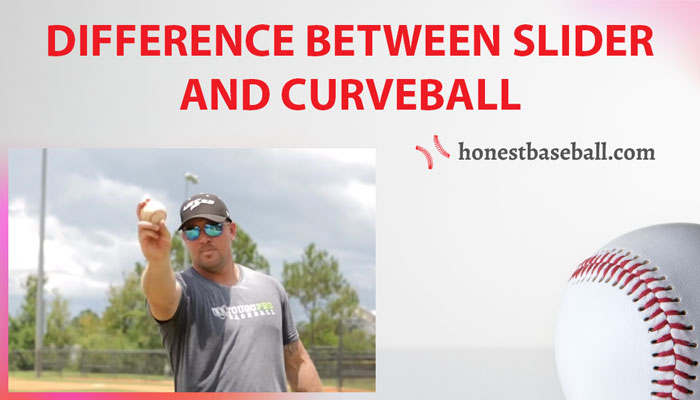Last Updated on November 16, 2023
The curveball and the slider are both examples of breaking pitches, although they are not interchangeable.
To the hitter, a curveball breaks abruptly downward and away from the pitcher. It’s thrown more vertically and at a slower pace.
A slider, on the other hand, is a quicker pitch that looks practically straight initially thrown but slides away from the batter as it gets closer.
The difference between a curveball and a slider rests in the speed, trajectory, and point of release during the pitch.
In 2020 MLB, the approximate spin efficiency of a Curveball was 68.7% (second highest), and the slider was 35.9% (lowest).
Still, most professional pitchers dominate the opponent with a curveball or a slider. But how do they do that? What is the science behind it, and how do players achieve those skills?
Hi, this is Jason Butler, a former baseball player and a school coach. In this article, I’m going to teach you about the difference between a curveball and a slider with a lot more stuff. So grab your coffee, and let’s begin.
What is the difference between a Slider and a Curveball?
At a Glance
| Feature | Curveball | Slider |
| Grip | Typically held with a tight spin grip | Held with a slight tilt and tighter grip |
| Movement | Breaks downward and sideways | Sharp, late break, more horizontal movement |
| Trajectory | Loopy, arcing trajectory | Flatter trajectory |
| Speed | Slower than a slider | Generally faster than a curveball |
| Difficulty to Hit | Can be challenging due to movement | Challenging due to late break and speed |
| Notable Pitchers | Clayton Kershaw, Barry Zito | Randy Johnson, Clayton Kershaw |
| Common Counts | Often thrown in 0-2 or 1-2 counts | Used in various counts, especially ahead |
| Strategic Use | Effective for changing eye level | Useful for inducing ground balls |
Now, I’ll show you the difference between a curveball and a slider one by one. Starting with a short history class. You won’t get bored, I promise.
1. The Origin
Curveball: The curveball pitch first came into light in early August 1870 at the Capitoline Grounds in Brooklyn. The pitcher was Fred Goldsmith.
Some believe the inventor of this pitch type is Candy Cummings, though it’s still under debate.
The first successful collegiate curveball pitcher was Clarence Emir Allen from Case Western Reserve University, formerly known as Western Reserve College, in Cleveland, OH. Tommy Bridge, Bob Feller, Herb Score, and Sandy Koufax are some of the curveball legends.
Slider: In 1920, the curveball pitch was first used against the St. Louis Browns. At that time, it was called the “Nickel Curve”.
Though the inventor of this pitch type is yet to be proven, some believe it to be Chief Bender. Using this pitch, Bender won 212 games in his career with 6 World Series.
2. What are Slider and Curveball Pitches?
Expecting some sentences with difficult words and terms? Relax, you’re not in the classroom, and I ain’t your teacher. In this section, I will define the slider and curveball pitches in a way that you can learn easily.
Curveball
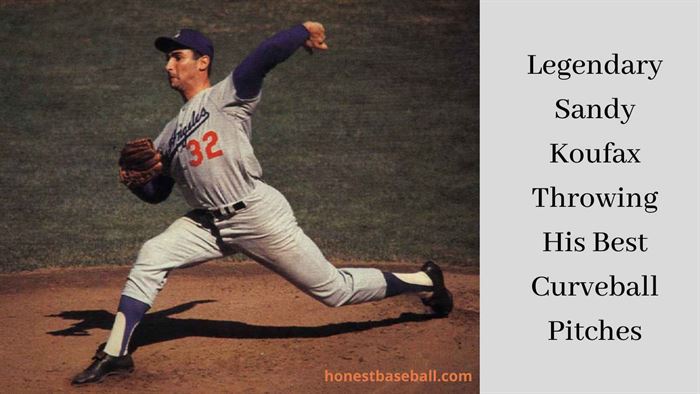
Being a Pitcher, I had always liked the curveball and tried to deliver the best. It’s breaking pitch with a lot more movement, thrown slower with overhaul breaks. When executed properly, the hitter will swing a bit earlier, expecting a fastball, and miss the pitch. This keeps the hitter away, especially from taking fastball preparation.
Curveball Pitch has some nicknames like “Hook”, “Bender,” “Uncle Charlie,” “Deuce,” and more.
Slider
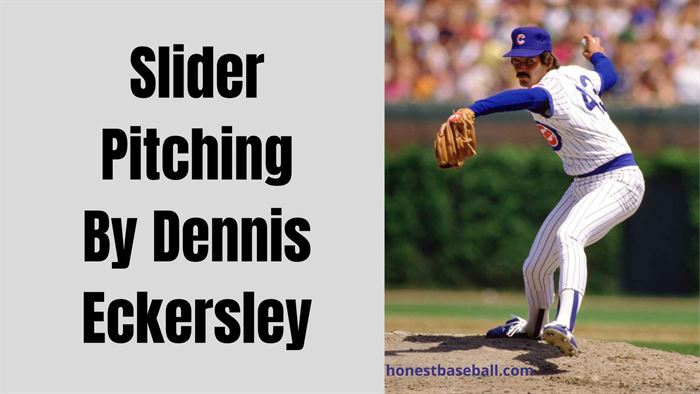
On the other hand, the slider has a breaking pitch, which makes it a bit more difficult for the hitter. It is thrown faster, like a fastball, but with less movement than a curveball.
The delivery is released using a combined technique of Curveball and Fastball.
It’s deceptive more than a curveball as it’s thrown faster with spin at the same time, with a close resemblance to a fastball. Another form of a slider pitch is “Slurve”.
Besides, slider pitch is also called “Snapper,” “Breaking Ball,” or “Slide Piece.”
3. The Variations
Some of the common Curveball pitches are:
- Regular Curve: It’s just like another curveball pitch used to decrypt the hitter and make a score.
- Sweeping Curveball: The sweeping curve adds a little more speed than a regular curve. This pitch is delivered with an angle between straight overhand and straight sidearm. This creates a diagonal type of toss, and the hitter misses.
- 12-6 Curveball: This pitch is delivered in a way that you see the forearm coming vertically up, and then suddenly, the ball breaks straight down. This can be performed like 1-7 or 2-8, but the strategy is the same.
The slider variations are:
- Regular Slider: This ball comes a bit slower (around 8-10 mph) than a fastball but turns at the very last moment.
- Hard Slider: This pitch is thrown around 2-3 mph faster than a regular slider baseball pitch
4. The Grip
The key difference between a curveball and a slider mostly lies in the grip. It is one of the most crucial parts of perfect pitch delivery. If you fail to do so, the hitter will notice it shortly and score easily. Below I’ll show you the anatomy of curveball grip along with slider grip:
Curveball Grip
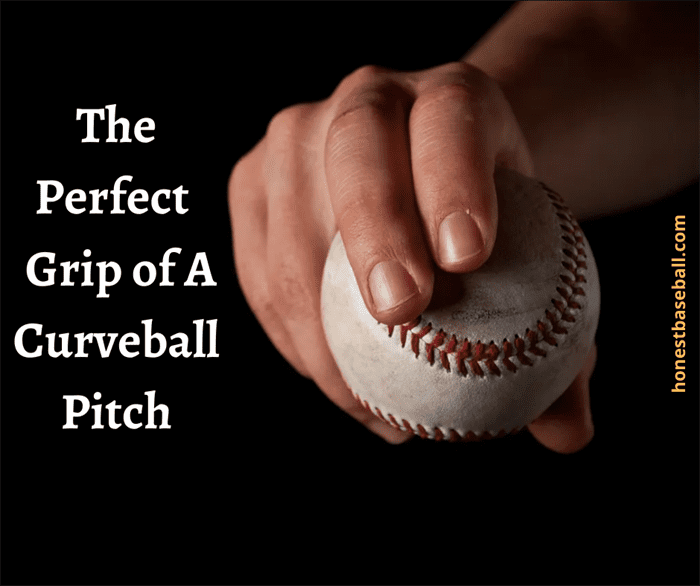
The very basic rule to curveball grip is placing the middle finger along the bottom seam and thumb on the back seam of the baseball. During the pitching delivery, the thumb on the back seam will rotate upward, and the middle finger will force back downward accordingly.
For more details about curveball gripping, you can take a look at the brief.
Slider Grip
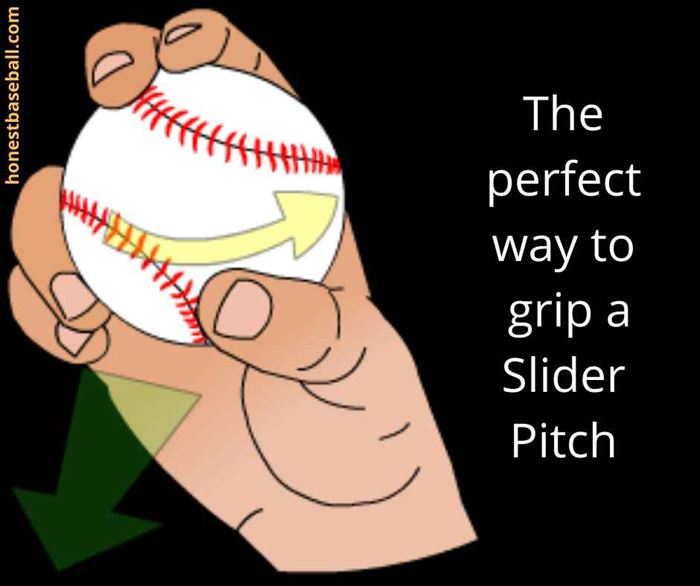
The gripping technique of a slider baseball pitch is almost the same as a curveball. Hold the index and middle finger at the top of the baseball and place the thumb just beneath.
Here, some may prefer a bit different. Like holding the ball with the index and middle finger at the top and the rest of the fingers at the back. In both cases, the grip is your target, so try the comfortable one.
Want to throw a slider pitch at once but still need some more guidance? I have a separate article on slider pitching. Here, I have described how to throw a slider in baseball with all the necessary details.
5. The Science Behind A Slider and a Curveball
If you want to be a successful pitcher, then you must know the ins and outs of all the baseball pitches. This is followed by the coach’s guidance, lots of practice, and, most of all, Science. When you know the science behind any pitch, most of the task gets easier.
As a coach, I always encourage my fellow students to work on both science and practice symmetrically.
The Pitch Movement Chart
I know you’re thinking about learning the science straight and surprising your practice-mates. But trust me, the pitch movement chart has a lot to learn from. As a former baseball player, I strongly recommend you study it.
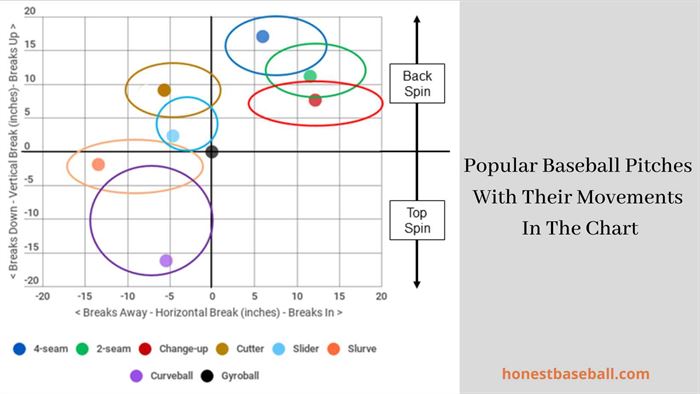
Almost all baseball fans know about the types of baseball pitches. In the chart above, I tried to demonstrate almost all the types of pitch with particular pitch movement points.
Here, you’ll find 8 different colors representing a particular pitch type. Break up, Break Down, Back Spin, and Top Spin classification will help you to understand the concept intensely.
Curveball Science
The very common Magnus Effect is the key factor behind all the curves. Which describes “When a spinning sphere or a cylinder curves away from the arc it would follow if it weren’t spinning”. This effect is commonly used in football, volleyball, and even cricket.
A fastball with a backspin traveling through the air creates a high-pressure area in the air ahead of the baseball and deflects downward in flight.
Also, gravity partially encounters the ball in the air. This way, fastballs fall less during the home plate.
In case you want to know the science behind the curveball visually, here is an opinion.
Slider Science :
As I said earlier, the slider is a combination of curveball and fastball, but not on the whole. According to a report from 2019, the average velocity of a slider is about 8-10 miles shorter than a fastball.
So basically, there is no exceptional explanation besides the gyro factor, AKA Gyroscope. You don’t have to use the gyroscopic meter, just the angle. This gyroscopic angle, along with the gripping technique, allows you to pitch like a fastball with a lower speed but react differently than a regular curve one.
Speaking of Fastballs, I have an article on how to increase pitching velocity by 10 mph. Here, you’ll get a brief guide on the fastball.
6. Chances of Injuries
No, this is not what you thought earlier. This is about the effect that a pitcher faces during their career, even sometimes lifelong. Both baseball pitches, slider and curveball, create enormous amounts of strain on the arm, more specifically the elbow and shoulder, starting with the wrist.
Most baseball coaches are very much aware of the practice, where some of the league prohibits baseball pitch usage up to a certain age, like 13 years old. History tells a lot about the sufferings where pitchers ended their careers blowing their arms at both pro and college levels.
Though it’s hard to blame, particularly one Baseball pitch, the price remains the same.
Improving pitching speed in important for your career. To improve speed, you need to track your speed. So, professional players use baseball radar gun.
Difference Between A Curveball And A Sinker
Bonus is always an attraction to us. So Tried to maintain that in writing, too. In this section, I’ll talk about sinkers and differentiate them from curveballs.
Sinker Vs. Curveball

You may be wondering what you would do knowing about Sinker vs Curveball, right?
Well, I must say, both of these pitches have been countering the hitters for more than a century.
Now, coming to your question. The key reason to know about Sinker Vs. Curveball, aka sinker or curveball, is these types are pretty much close. You may have already experimented with this pitch type unconsciously, but now it’s time to know a bit more.
Sinkers drop at the very last moment of the flight. This causes the hitter to strike the top of the ball, which turns into a ground ball.
Thus, most of the sinkers are called “Groundball pitchers” too. One of the most exciting groundball pitchings in MLB to increase your adrenaline rush
A perfect curveball pitch not only depends on mastering this. As there are some other factors like wind speed, weather, and even pitcher’s condition, these can affect the right curve. On the other hand, experienced sinkerball pitchers depend only on the pitch.
Curveball Or Slider: Which one is most difficult?
If you count curveballs first, then the answer is yes, but not all the time. The experienced hitters just swing their heels and hit the ball to a long distance.
Every hitter wants to score against curveballs, but this demands lots of experience, patience, and practice. Most of the time, minor leaguers fall in their career just because of not hitting the curveballs.
On the contrary, sinkerballs are quite easier to hit as they don’t break like curveballs.
But still, they are difficult for every hitter. At first, they seem like a fastball coming forward and falling at the very last moment. As it seems fast, the hitters swing the bat a bit earlier, but it turns into a groundball.
Some people say teams with experienced curveball and sinker pitchers act like bulldozers to their opponents.
As a former baseball player, I had the chance to feel these pitches in action. In case both teams have the same game plan, then it’s hard to predict.
Knowing When to Use Each Pitch
When it comes to curveball versus slider, in different game situations, the pitch chosen can make all the difference.
Let’s just think of this scenario: you are in a tight spot, it’s the bottom of the ninth, two outs, and the tying run is on third. In such instances, one would prefer throwing a slider.
It is fast, hard to anticipate, and likely to result in a swing and miss from the batter.
Now, let’s look at another scene. It’s the beginning of the game, and there are no runners on base. You can come out strong and set the tone for the rest of the game at this point. That’s when you should throw a curveball.
Its drop and slow makes a batter hard for him/her to hit well, giving your team a morale boost. Keep in mind that the right pitch at the right time could be enough to turn this whole match on its head.
The Pros & Cons of Using a Slider Versus a Curveball
In comparing curveball vs slider, these pitches have their own advantages and disadvantages associated with them. As for the slider, it is a fast pitch with a sudden break, making it highly tricky.
This one works perfectly, especially if you have two balls against one batter who needs only one for a swing and miss.
However, because of its speed, you should be careful with the slider – once connected by a bat; it can go far beyond the limit.
In contrast, curveball has slow, dramatic moves, even deceiving some great batters. This means that it helps create uncertainty as well as controls pace early during games, while poorly thrown curveballs might serve as easy prey for those ready batters.
The key to maximum effectiveness lies in understanding the situation, reading the batter, and deciding which pitch will most likely lead to a swing and miss.” Whether it is a slider or curve ball, remember your strategy is as important as your execution.
Hence, practice both pitches and be prepared to use them when necessary.
Some Famous Baseball Pitchers In History
There’s always some legend who used to find a unique solution and pass it through. In the history of Baseball Pitching, there are some, too.
- All-times Legends of Curveball Pitching
- Sandy Koufax – Los Angeles Dodgers.
- Bert Blyleven – Minnesota Twins.
- Dwight Gooden – New York Mets.
- Camilo Pascual – Washington Senetors. All-time
- All-time Legends of Slider Pitching
- Randy Johnson – Arizona Diamondbacks.
- Steve Carlton – Minnesota Twins.
- Bob Gibson – St. Louis Cardinals
- Sparky Lyle – Boston Red Sox, Chicago White Sox, New York Yankees, Texas Rangers, Philadelphia Phillies
- All-time Legends of Sinker Pitching
- William Charles Swift – Seattle Mariners, San Francisco Giants.
- Gregg Alan Maddux – Atlanta Braves, Chicago Clubs
- Mathew James Albers – Houston Astros, Boston Red Sox, Chicago White Sox, Washington Nationals, Baltimore Orioles, Milwaukee Brewers.
- Brad Steven Bargesen – Baltimore Orioles, Arizona Diamondbacks.
There are many more legends who have enriched the history of baseball and entertained the world.
Frequently Asked Questions
1. Which one is better: slider or curveball?
A slider is thrown a bit faster than a curveball with less movement. Its breaking capability and velocity are much more unique and powerful than other pitches. So you may count Slider pitches.
2. What’s the difference between a cutter slider and a curveball?
In short, the difference lies in the two questions: when and how. If you can determine the time and the percentage of the pitch break, the main difference will be clear to you.
3. When should you throw a slider?
The average age to start throwing a slider is between 14 and 16 years. However, it’s found that young slider pitchers often suffer more arm pain than other pitchers.
4. What sets a slider apart from a curveball?
The primary distinction lies in their speed and movement characteristics. A slider is generally swifter and exhibits a belated, sharp horizontal break, whereas a curveball manifests slower velocity alongside a more accentuated downward break.
5. When should a pitcher opt for deploying a slider versus utilizing a curveball?
The choice between employing either pitch hinges significantly upon factors such as game circumstances and evaluating the batter’s tendencies.
A slider can prove exceptionally potent when confronted with critical moments that call for an unpredictable pitch. Conversely, a curveball can serve as an ideal selection for launching the game with vigor, setting the tone for subsequent plays.
6. Does the grip significantly differ when executing a slider versus a curveball?
Indeed, the grip does diverge when executing these two pitches. A curveball necessitates holding the baseball with your middle and index fingers together across the seams.
In contrast, executing a slider necessitates positioning your fingers nearer to the narrow seams of the baseball.
4. Which pitch poses greater difficulty for batters to connect with a slider or a curveball?
Both pitches can pose unique challenges for batters due to distinct reasons. A slider’s swiftness, coupled with its delayed break, can render it arduous to connect with.
Simultaneously, a curveball’s decelerated velocity alongside its dramatic descent also proves highly deceptive.
5. What are some common errors committed when hurling a slider or curveball?
Common mistakes encompass failure to complete follow-through entirely, inconsistency in executing throwing motions, and inaccurately locating pitches.
For both pitches, consistent practice remains key in avoiding such errors and fostering improvement.
Last Words
So far, I have tried to describe and analyze the difference between a curveball and a slider, along with a sinker vs curveball differentiation. I have written another article about the best pitches to throw in baseball. In case you want to know more about the best and most effective pitch formats, it can show you the path.
Selecting the best one may seem fancier, but not always effective. You don’t even have to learn all the multiple baseball pitch types. Just pick the one you like most and suits you in body aspect, and master it. Best wishes.

Hello everyone. My name is Jason Butler, and I live in California, America. I was a professional AAA Minor League Baseball player. I lost my chance of playing MLB for injury issues, but I did not lose my love for baseball. I attended the coaching training program and am now working as a coach in a small school in San Diego.
I always love to share my experience and knowledge if that can help you. Play baseball, and stay fit.
